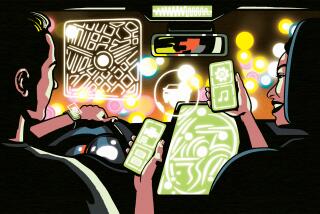Mobile Video on a Roll
- Share via
The drive-in theater may be nearing extinction, but the driving theater is rapidly evolving into a standard feature of today’s automobiles.
Watching television on the road used to be a guilty pleasure in big recreational vehicles or converted vans. Installation was often crude, with clumsy 9- or 13-inch televisions, bulky VHS players and their obligatory wood frames with peeling fake-walnut veneer.
We put up with it because the TV succeeded where counting license plates didn’t--in keeping children happy on long trips.
When the advent of smaller video screens allowed cleaner installation, owners of upscale minivans and sport utility vehicles started asking mobile-electronics stores to install video baby sitters in their back seats.
“Mobile video is our single biggest growth area,” said John Haines, purchasing manager of the 35-store Al & Ed’s Autosound chain. “In some stores, it’s the No. 1 product category.”
The Consumer Electronics Assn. predicts that more than 400,000 mobile video units will be installed this year.
Automobile manufacturers began offering integrated rear-seat entertainment systems in 1999 with the Oldsmobile Silhouette.
Today, all but three minivan manufacturers include factory-installed mobile video as an option, and by the 2003 model year, those three--Kia, Dodge and Chrysler--will have factory programs in place.
Upscale SUVs such as the Infiniti QX4 and GMC Envoy already are in the video zone. In the pickup market, Ford became the first to offer a rear-seat entertainment system--in its F-150 SuperCrew--at the end of last year.
The lone holdout was the family sedan segment, but this year Saturn built 1,000 special-edition L300 sedans (and wagons as well) with a $3,550 DVD player option. “They sold out immediately,” said Saturn spokesman Chuck Harrington.
DVD has eclipsed VHS as the standard player format. Its compact size allows convenient mounting, and the discs are easier to manage than tapes.
Mobile video is a big-ticket item at sound shops because customers often upgrade the audio system, add video games or include a navigation unit. Even 5.1-channel surround sound--an exotic feature usually found in the home theater--has been adapted to the automobile.
“All you need is a 12-volt popcorn maker,” quips Howard Becker of Oxnard-based Becker Automotive Designs Inc., one of the nation’s leading luxury vehicle conversion companies. With a customer base that reads like Vanity Fair’s post-Oscars party list, Becker offers anything-goes, cutting-edge mobile audio and video systems that can easily top $25,000. His systems usually are designed with enough monitors, multiple players and intricate switching controls to enable each passenger to play video games or watch different movies at the same time.
The social implications of this modern wizardry cannot be ignored. Extending family cocooning to the automobile may be a noble gesture, but it could bring on separation anxiety.
“I felt like a chauffeur,” says Becker, who owned a Chevrolet Suburban fitted with six screens, five different video and game sources, 15 speakers and six headphones when his children were younger. “Even my wife got in the back seat to watch movies until I mounted a screen on her sun visor.”
More electrical gadgets and quality entertainment systems are in the future.
Satellite radio and MP3 capability already are factory options, and wireless integration of cell phones, PDAs and other networking electronics is near. Upgraded navigation systems will include real-time traffic reports as well as telematics to notify parents if their teenagers drive to restricted locations.
Manufacturers also are teaming with respected audio companies such as Bose, Harmon Kardon, Pioneer, McIntosh and Mark Levinson to lure discriminating audiophiles. And Lincoln is the first auto maker to have its audio system certified by Lucasfilm THX.
All this digital and auditory pleasure has a downside: driver distraction. Most states forbid drivers to watch entertainment programs on dash-mounted screens, but customers often pressure installers to bypass lockout measures.
Manufacturers and audio companies are using methods both subtle and active to keep drivers’ eyes on the road. Menu-driven programs will become simpler to operate and control buttons more convenient.
“Each knob could have a specific texture so drivers can distinguish them quickly,” suggests Cindy Moreen, marketing manager for Mopar Accessories.
Says Michael Townsen, vice president of marketing for mobile entertainment at Pioneer Electronics: “Voice activation will soon be used to control audio and video functions.”
He notes that an upcoming Pioneer product will handle 600 voice commands for navigation, video and audio systems.
Then drivers who are feeling ignored can at least talk to their dashboards while everyone else in the vehicle is watching a flick or playing a favorite video game.
*
Mike Magda writes about automobiles and automotive products. He can be reached at mmagda@earthlink.net.





